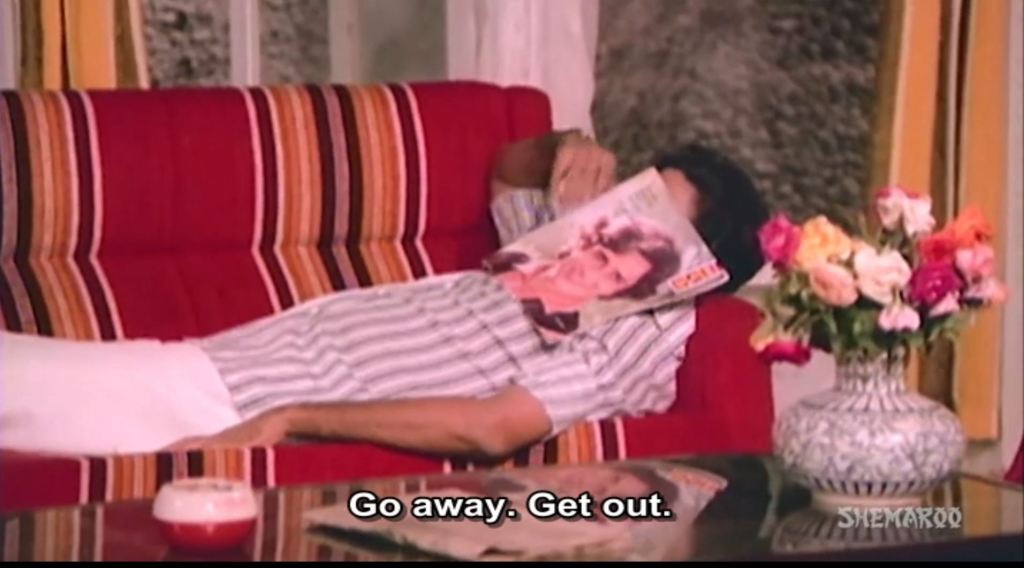
Having just finished Naalayak, I felt frustrated. The film had such little substance that I despaired of properly writing about it, even in a negative tone. Yet it is also a less-remembered production about which minimal information is available on the internet. My stop-gap solution—one that I expect will bear future repetition—is to group Naalayak together with a few other movies that inspired the same sentiment when I first saw them over the past year or so. All are films that I found unenjoyable, but also in some fundamental way uninteresting. The latter failing is significantly the worse, to my mind! Hopefully it will be of some utility to record even these brief opinions and my estimation (wherever I can venture one) of the sorts of viewers who might actually find these films worthwhile.
Ab Kya Hoga (1977)
A fancy businessguy (Shatrughan Sinha) is tormented by a woman who may or may not be alive (Neetu Singh) and who may or may not be the fiancé of his colleague (Asrani). Sawan Kumar wrote, produced, and directed, with music by Usha Khanna as per usual; Mercury Pictures released it.
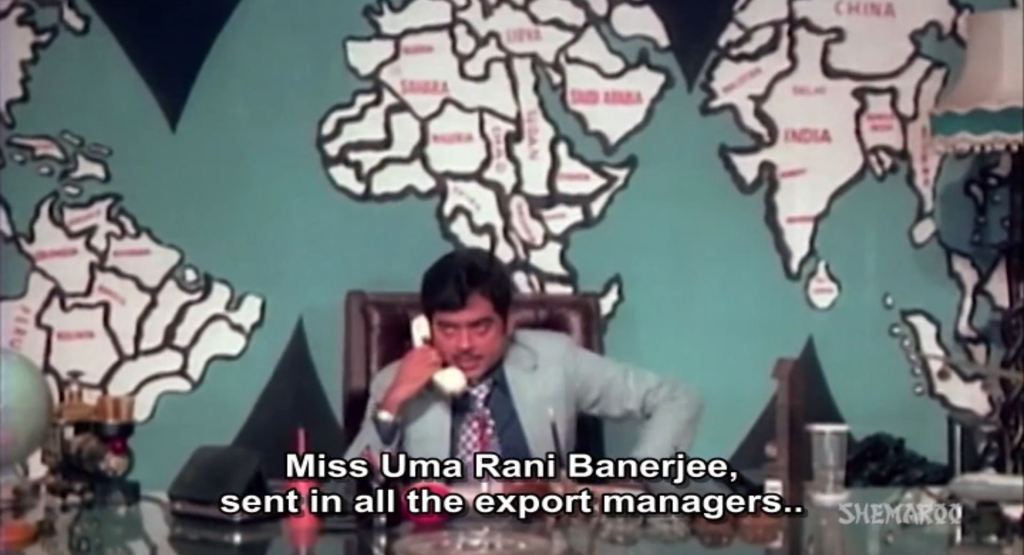
I maintain a pretty high opinion of the Sawan Kumar/Usha Khanna B-movies; they played a crucial part in this blog’s history, after all. “Possibly ghostly women tormenting people” is a favorite subgenre of mine, nor do I resent it when such ladies inevitably turn out to be figments of the hero’s imagination or Bindu in a rubber mask or what have you. Alas, this particular entry courts comparison to Woh Kaun Thi without at all rivaling that film’s surface-level beauty, depending on atmosphere to carry one’s attention forward while making the mystery itself openly unmysterious. My darling Neetu was pretty well wasted in it. There are some naive charms to be gleaned from its blatant jugaad—yes, the country straight above his head in that map is simply named “Sahara.” The film also deploys familiar faces in highly atypical parts.1 Besides Asrani’s strictly dramatic role, fans of Shatrughan (I’m not one) may appreciate watching him play this bewildered, vulnerable fellow.
Himalay Se Ooncha (1975)
Following a mountain plane crash, rival ski instructors (Sunil Dutt and Ranjeet) rush to rescue the survivors (Rakesh Pandey and Masters Raju and Bittoo) and/or avail themselves of the gold that was being smuggled aboard. The story2 is by Mohan Kaul with dialogues by Satish Bhatnagar; B. S. Thapa directed and Babboo Mehra produced for Prakash Mehra Combines. Music is by Kalyanji Anandji.
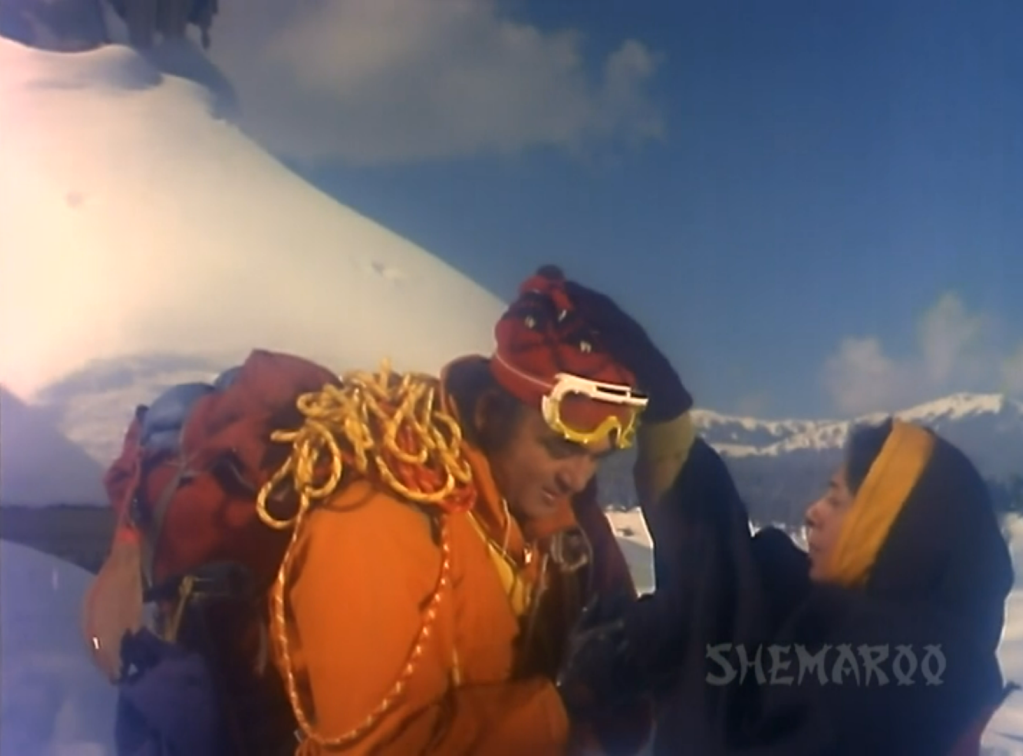
Of these four films, Himalay Se Ooncha is the one that most closely approached the status of interesting failure. The first half-hour or so had set up a fairly serious-minded, psychologically focused survival drama and Rakesh Pandey in particular acts his little heart out in it. Then the script starts shuffling its players back and forth between the same few physical and moral positions with no well-considered trajectory. The children get saddled with truly unbearable stuff, such as a song in which they wander away from the group, accidentally get drunk on brandy in an attempt to warm themselves up, and mistake one other for wild animals. It’s a pity. The technical challenge of shooting on mountain locations (Kolhai Glacier, Thazwash Glacier, Sonmurg, Gulmurg, and Khilanmurg, according to the credits) is surprisingly well-handled; even via a damaged print, the beauty of those landscapes shines through. Recommended also to those who find Ranjeet hot even when he’s muffled up in five layers of sweaters.
Naalayak (1978 or 1979 or something)
A gambling-addicted wastrel (Jeetendra) has to prove the innocence of his brother (Satyen Kapoo) when the latter is accused of murdering a different gambling-addicted wastrel (Bindu in a puzzling wig). Leena Chandravarkar is notionally the heroine but functionally absent from the film. N. A. Narayan wrote the story and screenplay and Ahsan Rizvi the dialogues; the film was directed by Padmanabh and produced by Jagdish Sharma for Veena Films. Kalyanji Anandji again provided the music.
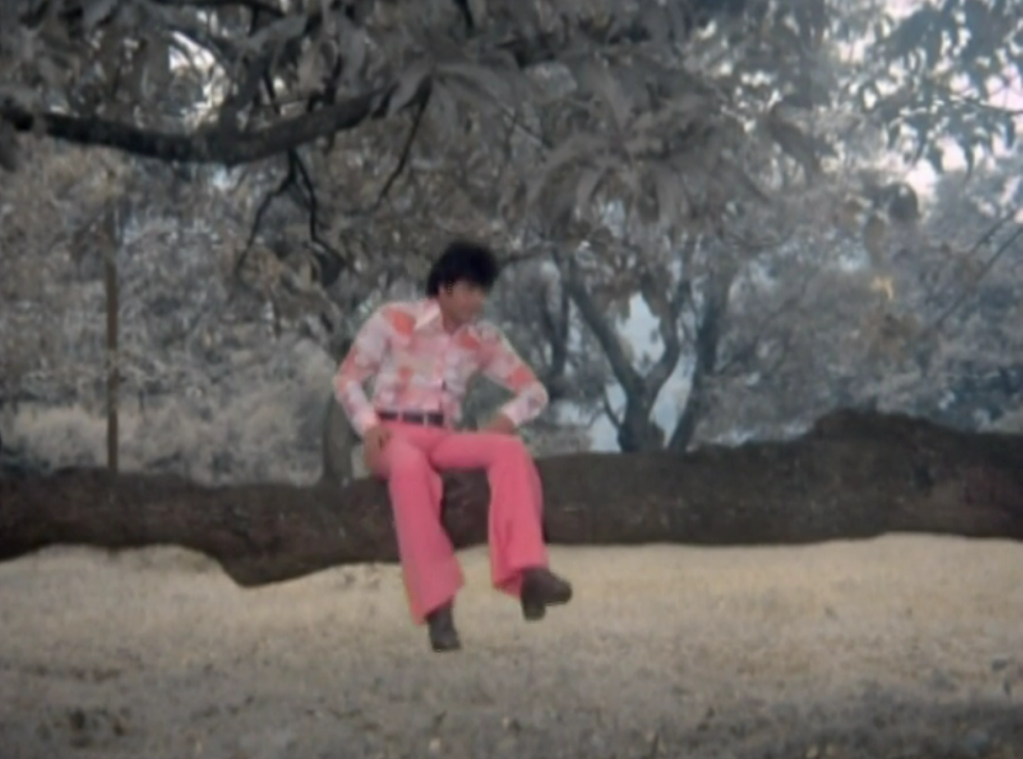
Although the two halves of this film had nothing to do with one another, both of them bored me almost to tears. Following Jeetu on his nightly rounds through the casino was a weirdly joyless endeavor only sporadically enlivened by decorative or sartorial fancy, and when the murder mystery finally kicks in it is decidedly of the Just Some Things Happening school. Jeetu is constantly whispering his plans into other characters’ ears, because if the audience were to hear them aloud there would be nothing for the film to flail around doing for the next fifteen minutes. For this one I really am inclined to tell people simply to listen to the songs; three out of the four are excellent. I assure you that they are just as creepy in the context of the film as they seem like when excerpted on YouTube!
Pyar Ke Do Pal (1986)
Separated twins (Master Ashutosh) try to parent-trap their mom (Jaya Prada) and dad (Mithun Chakraborty) into getting un-divorced despite the machinations of the mom’s purported best friend (Simple Kapadia). The screenplay is by Jyoti Swaroop from a story by Z. D. Lari and with dialogues by Javed Siddiqui. Parvesh C. Mehra produced and Rajiv Mehra directed; the film was released by United Producers and Eagle Films. Music is by Anu Malik.
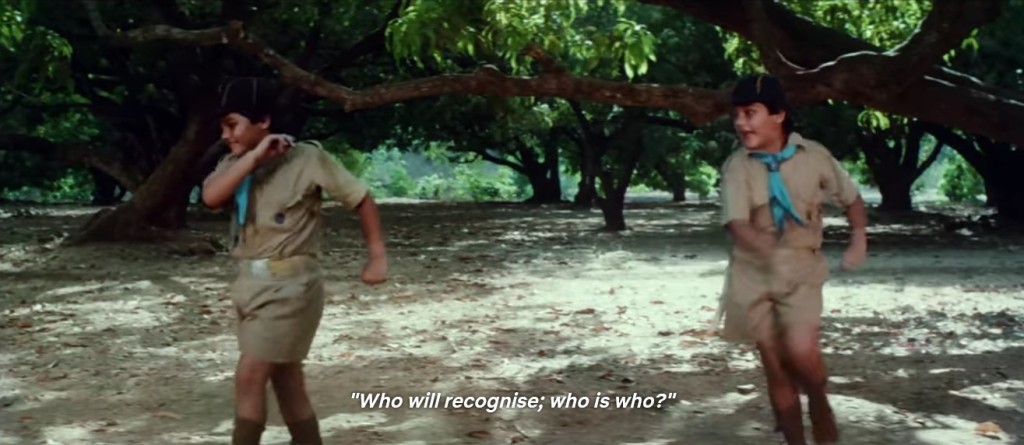
This movie indulges in my all-time least favorite varietal of filmi melodrama: the whole universe conspiring to make an innocent party appear unassailably guilty. (Naalayak has some of the same flavor post-interval, for the record.) I always find these kinds of stories annoying to watch. One sympathizes with misunderstood Mithun, but at the same time it’s impossible to fault Jaya Prada for distrusting him when she has no demonstrated reason to do otherwise—and also vice versa, because both of our main characters are marooned in this situation! Ashutosh Thakur acquits himself well above the usual standard of child actors and the twins’ song (“Main Hoon Main,” pictured above) was surprisingly adorable. If preemptively girded against narrative frustration and endemic mid-’80s sleaze, I imagine connoisseurs of high camp may find something to enjoy in here; Simple’s character is certainly one of the most unremittingly wicked villainesses I’ve seen in a Hindi film.
1 This phenomenon is not limited to major players. When Mac Mohan turned up in a scene set at a museum, I expected him to start stealing the art; he turned out to be the curator.
2 According to the opening titles, this was in some way inspired by Maj. H. P. S. Ahluwalia’s memoir Higher Than Everest—although if Ahluwalia ever wrestled a sun bear, I’ll eat my shirt.
I feel for you, but I can’t help but laugh, too. This was such a delightful set of mini-reviews. I have to admit I haven’t seen any of these, but this: although if Ahluwalia ever wrestled a sun bear, I’ll eat my shirt – tempts me to at least try watching Himalaya se Ooncha. 😀
LikeLike
Further Googling suggests that Ranjeet may actually be up against an Asian black bear, which makes more geographical sense than a sun bear even if it it still looks terribly confuzzled to have found itself in this icy landscape:
Don’t tremble for Master Bittoo; the children have already befriended the bear by removing airplane debris from its paw a la Androcles.
LikeLike
This I have to see.
LikeLike
I assume no liability for the risks inherent to this endeavor ; D
LikeLiked by 2 people
😀 Absolutely not, I assure you! I watch at my own risk.
LikeLiked by 1 person
This was such a fun read and just as important (if not more) than the movies you have recommended. I don’t think I have seen any of these, although Nalayak sounds familiar. Regardless, it failed to make much of an impression on me if I did see it. I will stay away from these movies.
LikeLiked by 1 person
Thank you for my morning laughs, though I sympathize with your ordeal (and the wasted hours you will never get back). I giggled at someone wrestling a sun bear, and thankfully wasn’t drinking my tea when I read it.
LikeLiked by 1 person